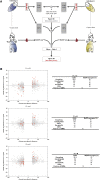Guthrie card methylomics identifies temporally stable epialleles that are present at birth in humans
- PMID: 22919074
- PMCID: PMC3483543
- DOI: 10.1101/gr.134304.111
Guthrie card methylomics identifies temporally stable epialleles that are present at birth in humans
Abstract
A major concern in common disease epigenomics is distinguishing causal from consequential epigenetic variation. One means of addressing this issue is to identify the temporal origins of epigenetic variants via longitudinal analyses. However, prospective birth-cohort studies are expensive and time consuming. Here, we report DNA methylomics of archived Guthrie cards for the retrospective longitudinal analyses of in-utero-derived DNA methylation variation. We first validate two methodologies for generating comprehensive DNA methylomes from Guthrie cards. Then, using an integrated epigenomic/genomic analysis of Guthrie cards and follow-up samplings, we identify interindividual DNA methylation variation that is present both at birth and 3 yr later. These findings suggest that disease-relevant epigenetic variation could be detected at birth, i.e., before overt clinical disease. Guthrie card methylomics offers a potentially powerful and cost-effective strategy for studying the dynamics of interindividual epigenomic variation in a range of common human diseases.
Figures



Similar articles
-
Analysis of Guthrie cards could provide insight into the epigenome at birth.Epigenomics. 2012 Oct;4(5):480-1. Epigenomics. 2012. PMID: 23275982 No abstract available.
-
The promise and challenges of blood spot methylomics.Epigenetics. 2013 Aug;8(8):775-7. doi: 10.4161/epi.25357. Epub 2013 Jun 19. Epigenetics. 2013. PMID: 23880534 Free PMC article. Review.
-
Epigenomics in stress tolerance of plants under the climate change.Mol Biol Rep. 2023 Jul;50(7):6201-6216. doi: 10.1007/s11033-023-08539-6. Epub 2023 Jun 9. Mol Biol Rep. 2023. PMID: 37294468 Review.
-
The effect of genotype and in utero environment on interindividual variation in neonate DNA methylomes.Genome Res. 2014 Jul;24(7):1064-74. doi: 10.1101/gr.171439.113. Epub 2014 Apr 7. Genome Res. 2014. PMID: 24709820 Free PMC article.
-
Independent genomewide screens identify the tumor suppressor VTRNA2-1 as a human epiallele responsive to periconceptional environment.Genome Biol. 2015 Jun 11;16(1):118. doi: 10.1186/s13059-015-0660-y. Genome Biol. 2015. PMID: 26062908 Free PMC article.
Cited by
-
Epigenome wide comparison of DNA methylation profile between paired umbilical cord blood and neonatal blood on Guthrie cards.Epigenetics. 2020 May;15(5):454-461. doi: 10.1080/15592294.2019.1699983. Epub 2019 Dec 9. Epigenetics. 2020. PMID: 31818188 Free PMC article.
-
Human transgenerational responses to early-life experience: potential impact on development, health and biomedical research.J Med Genet. 2014 Sep;51(9):563-72. doi: 10.1136/jmedgenet-2014-102577. Epub 2014 Jul 25. J Med Genet. 2014. PMID: 25062846 Free PMC article. Review.
-
DNA extracted from saliva for methylation studies of psychiatric traits: evidence tissue specificity and relatedness to brain.Am J Med Genet B Neuropsychiatr Genet. 2015 Jan;168B(1):36-44. doi: 10.1002/ajmg.b.32278. Epub 2014 Oct 29. Am J Med Genet B Neuropsychiatr Genet. 2015. PMID: 25355443 Free PMC article.
-
Going back to the future with Guthrie-powered epigenome-wide association studies.Genome Med. 2012 Oct 30;4(10):83. doi: 10.1186/gm384. eCollection 2012. Genome Med. 2012. PMID: 23131117 Free PMC article.
-
Infant's DNA Methylation Age at Birth and Epigenetic Aging Accelerators.Biomed Res Int. 2016;2016:4515928. doi: 10.1155/2016/4515928. Epub 2016 Dec 12. Biomed Res Int. 2016. PMID: 28058257 Free PMC article.
References
-
- Bibikova M, Barnes B, Tsan C, Ho V, Klotzie B, Le JM, Delano D, Zhang L, Schroth GP, Gunderson KL, et al. 2011. High density DNA methylation array with single CpG site resolution. Genomics 98: 288–295 - PubMed
Publication types
MeSH terms
Grants and funding
LinkOut - more resources
Full Text Sources
Molecular Biology Databases
